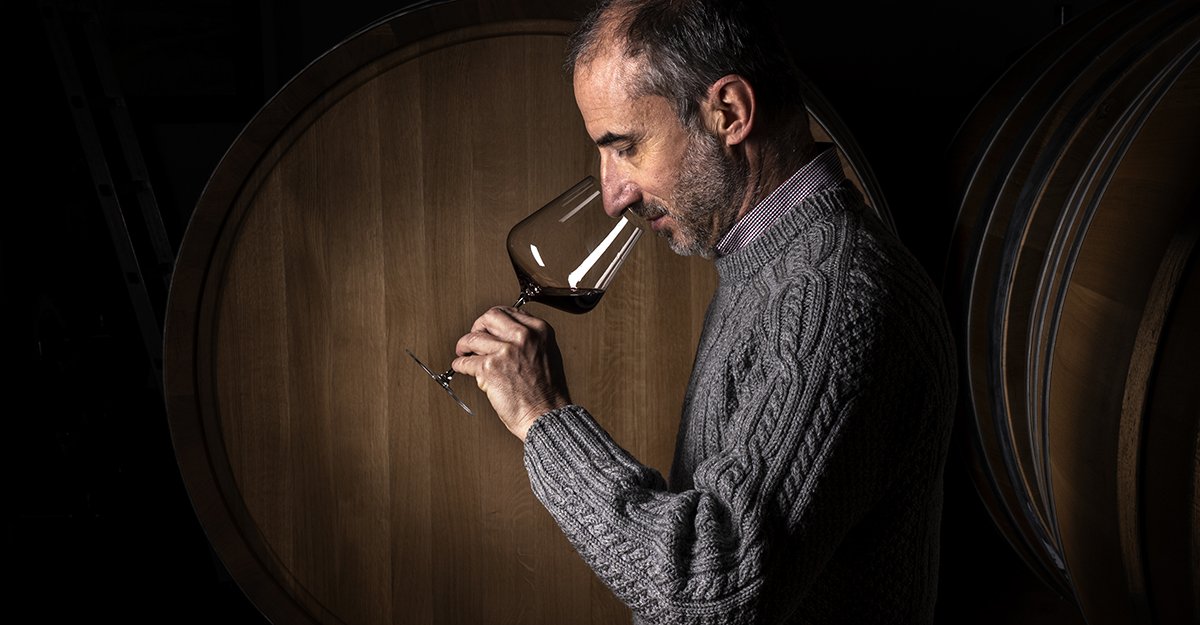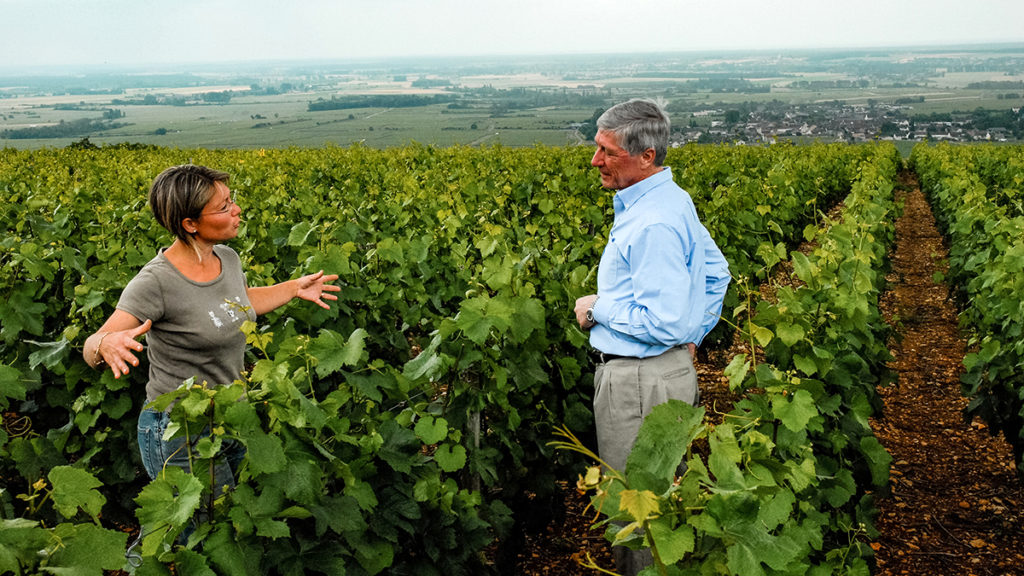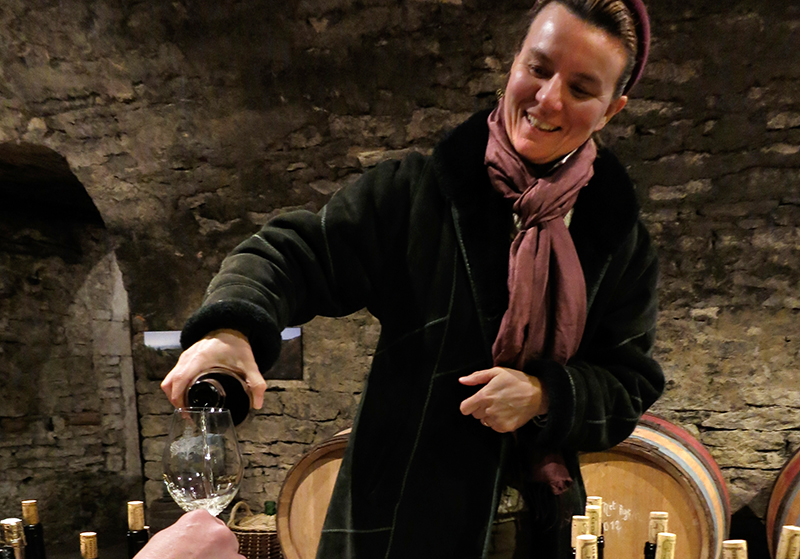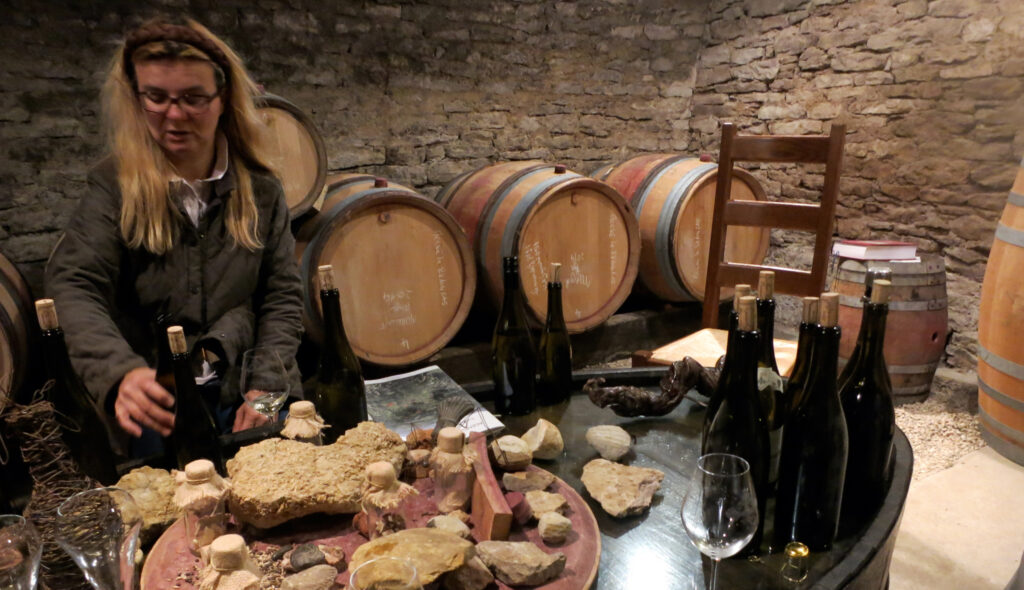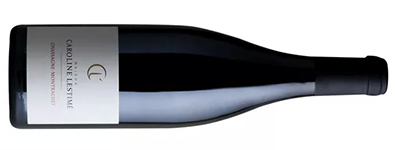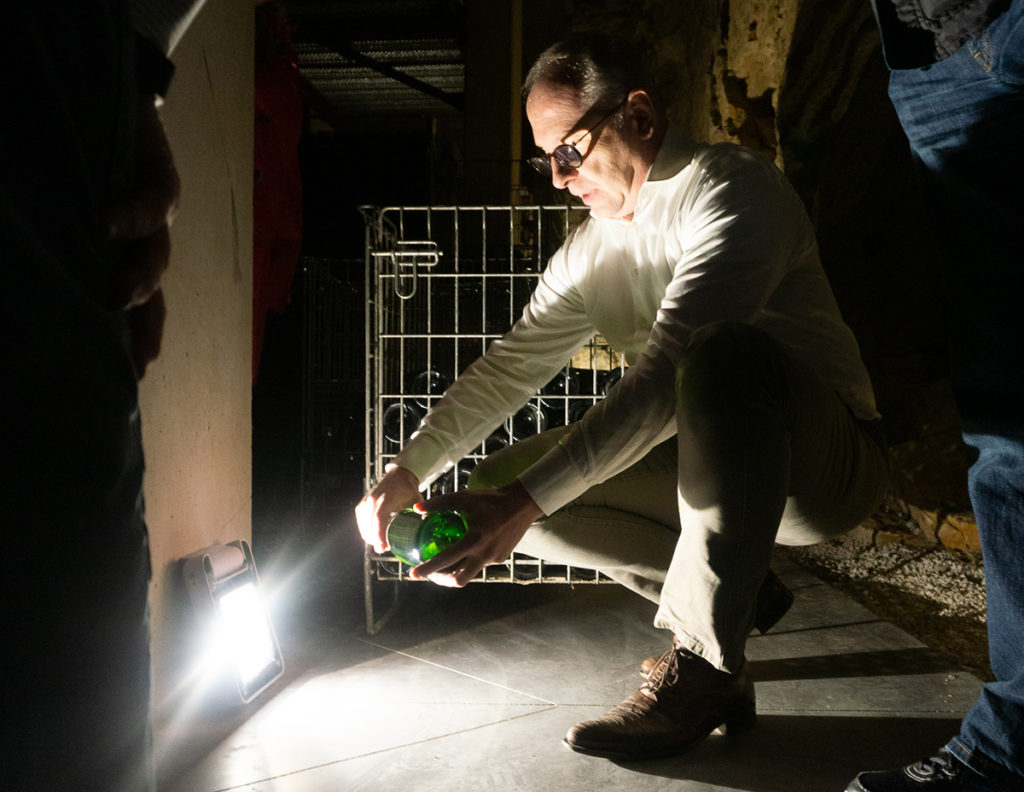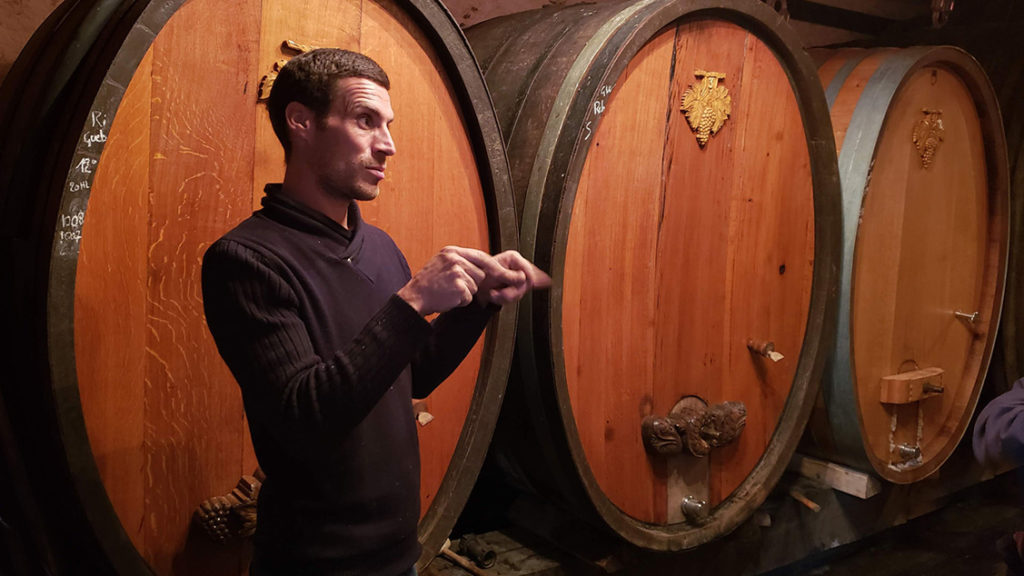The growing season of 2021 brought a sharp reminder that weather fluctuates, and that three consecutive years of particularly hot and sunny weather (18, 19, and 20) does not mean three more will follow. The year brought the viticultural equivalent of a plague of locusts in much of France, with terrible frosts succeeded by awful hail succeeded by pests and disease. In 2021 each challenge dramatically reduced the crop, and when we resumed our annual pilgrimages to France last Spring, the barrel rooms in Burgundy’s cellars were as empty as we have seen them in twenty years of visits. But Burgundy producers are used to all of these challenges (if rarely all in the same year); and over the past generation there have been more years like 2021 than years like the recent trio. Now that we are seeing 2021s come onto the market, we can confirm that the wines are attractive if scarce. There’s a reason for the rule of thumb that the best wines from any grape are made at the northern end of its range; and weather that gives vignerons headaches can add purity and clarity to the wine, rendering a truer expression of the place. Differences among the vintages add to the complexity of a region like Burgundy, but they also add to the pleasure. There’s plenty of variety in this offering. As usual, January Futures includes the excellent Tuscan wines of Poggerino, now made in two colors. There is much Burgundy, of course, but also wine from the northern Rhône and the Alsace. And there is the Grüner Veltliner from our only Austrian producer, of the Wachau region along the Danube. Finally, sparkling wine makes an appearance in Cremant de Bourgogne. We hope there will be something here for every taste and budget. If you find anything of interest, be sure to submit your orders, in case or half-case lots, by the Order Deadline of February 5, 2023. We will place orders for the wine immediately thereafter. JUMP TO SECTION
Thomas
Prunier
Lestimé
Picamelot
Tunnel
Frey/Gross
Bagatelle
Salomon-Undhof
Poggerino
January Futures
Order Deadline: 2/5
Gérard Thomas
St-Aubin, Burgundy
As usual, Gérard Thomas is the first of our Burgundy producers to offer their 2021s. We will taste most winemakers’ 2021s during our March visit to Burgundy, but Thomas’s wines, always in high demand, require quicker action; so we send for samples and place our order in January. After three consecutive hot, dry vintages in Burgundy, Mother Nature decided to mix in a changeup, throwing just about every possible malady at the long-suffering winemakers of the Côte d’Or. As Jasper Morris put it, “2021 was neither the best of times nor the worst of times, though it came close to the latter.” An April frost devastated much of France, with some producers losing as much as 90% of their crop in just two nights. Then the summer turned humid, causing high risk of oidium, rot, and mildew. Harvest in the second half of September was soggy and small. And yet by all accounts the 2021 Burgundies are quite often lovely. They show neither the concentration nor the ripeness of the last three scorching years, but instead carry a daintiness and precision that some (including us) find a welcome relief. Thomas’s four wines are all delicious in 2021 – a throwback in style to a decade ago perhaps, but in a sleek, modern package. Thomas’s Bourgogne blanc has long been a favorite among readers, and with many relying on it for their house white Burgundy. We’ve imported this wine for nearly 15 years, and those readers who discovered it pre-2015 will recognize an old friend in the 2021. (For those more familiar with recent vintages, picture a less intense wine with more lift — think flute rather than clarinet.) The nose shows sweet cream butter, with a lovely sucrocité. The mouth is dry and savory, trading the plump, tropical ripeness of recent vintages for a cool precision. Pair this with a plate of shrimp scampi in the spring; it’s a lovely everyday white. The two wines from Thomas’s hometown of St-Aubin are both delightful this year. The village level St-Aubin Champ Tirant is more earthy and savory than the Bourgogne, with less cream in the nose – it’s long in the mouth, with an easygoing mouthfeel and fresh finish. Jancis Robinson’s reviewer found “rich, broad fruit with precise, sculpted purity and freshness,” and “well-judged oak.” The St-Aubin Premier Cru “Murgers des Dents de Chien” (pictured, cover) is considered some of the best terroir in the village. Thomas’s 2021 shows smoke on the nose but not much oak, with a deep, pretty, floral character – it’s sophisticated in a way that calls to mind Puligny. On the palate it’s crackling and savory, with a long and tense finish that’s vibrant and lithe. Jancis found a “lees richness intertwined with the fruit,” with “pristine freshness” and “mouth-watering savor on the finish.” If there’s one white wine village whose character has most been shrouded in ripeness lately it’s Puligny-Montrachet. Classically a lean, chiseled, elegant wine, Puligny had to grapple with warm, tropical flavors of late and has at times seemed out of sorts. The 2021 vintage, with its modest ripeness and concentration, has allowed Puligny’s true character to shine through once again, and Thomas’s Puligny 1er cru “La Garenne” is a lovely example. The nose is chalky and precise with delicate white flowers and lime zest. The mouth is terrific, an honest, graceful Puligny free to be itself. We expect this to drink well for 3-4 years, and look forward to cracking one open this fall.
Domaine Michel Prunier
Auxey-Duresses, Burgundy
The side valley of Auxey-Duresses (OH-say dyoo-RESS) has long produced undervalued Burgundy – accessible wines with friendly pricing and early drinking windows. And while the surging tide of prices has begun to creep even into these corners, they remain excellent sources for value. Particularly in warm vintages like 2020, they can be every bit as good as wines of more famous zip codes. Michel Prunier and his daughter Estelle are among the brightest names in the humble town of Auxey-Duresses, and a favorite of Vinous writer Neal Martin. Martin has visited for over two decades, and characterizes them as an “old-school producer” with “premier crus worth hunting down, as they represent good value.” We’re pleased to offer three of Estelle’s 2020 red premier crus. In recent years Estelle has perfected her management of stems and oak treatment, and all three of the 2020 reds on offer are beautifully shaped. First, the Auxey-Duresses 1er cru – it’s a blend of three plots and raised in 30% new oak. The nose is terrific, a blend of dark cassis and spices like cinnamon and nutmeg. The mouth is very concentrated and long, with perfectly coated tannins. Neal Martin found “supple tannins, and fine acidity.” It might never pass as a Vosne or a Volnay, but it’s perfectly balanced, characterful red Burgundy. The Beaune 1er cru “Sizies” is delicious, showing Beaune’s classic stony character amid the inky fruit. The nose is intensely floral, with sweet red fruits and earth. The mouth is bold and very concentrated, but balanced expertly with a mineral line. Martin awarded 91-93 points, finding “pliant tannins…focused and taut,” concluding “this is very promising.” Finally Prunier’s finest wine, from Volnay’s finest vineyard, the premier cru “Caillerets.” The nose is dark and brooding, full of ripe cassis and toast. The mouth is classic Volnay, silky and elegant, but with an extra dose of muscle this year. Martin gave 90-92, finding “fine tannins, fresh and vibrant,” and remarking it “should age well in bottle.”
Caroline Lestimé
Chassagne-Montrachet, Burgundy
As Burgundy fans know, the past five years or so have seen a series of vintages with severely reduced yields owing to weather. One effect has been that many of the top winemakers began making wine from purchased grapes as well as from the vines they own. Caroline Lestimé, the longtime winemaker at the Domaine founded by her father Jean-Noël Gagnard, is among those who have branched out, offering such wines under the label Maison Lestimé. We tried a few of those white wines last year, and it was quickly apparent that her first-rate skills translate beautifully to grapes that she has purchased. We’re back at it this year, with a few reds to recommend as well a white. Last year the Maison Lestimé Savigny-les-Beaune “Les Planchots” 2017 was very well-received, and we’re pleased to have the 2020 vintage — an excellent one for Côte d’Or whites — in this offering. Savigny may be at the other end of the Côte de Beaune from Chassagne, but the quality of this wine and the winemaking are unmistakably in the Jean-Noël Gagnard style. The nose shows the signature blend of lemon fruit and oak in just the right proportions. In the mouth the wine is round and generous, but typical of 2020 whites, there is excellent supporting acidity that delivers attractive freshness. The length and finish show every bit of the Côte de Beaune pedigree. Caroline has offered us three Maison Lestimé reds this year, all from the 2021 vintage and all bottled under screwcap. A general word first about the 2021 vintage in red Burgundy: After three vintages characterized by extraordinary heat and historically early harvests, 2021 is a return to typical in terms of weight, ripeness and richness. (A host of issues from the weather – frost, hail, and more conspired to keep quantities at or near historic lows). It is what the French like to call “classique” and its virtue is in terroir-transparency and approachability rather than boldness. The first of these 2021s — a regional level wine from Hautes Côtes above Beaune — most clearly shows the differences from recent vintages. Maison Lestimé Hautes Côtes de Beaune “Clos Bortier” 2021 opens with a gorgeous, exuberant nose of fresh strawberries. The freshness carries through onto the palate, where its lighter weight leaves the focus entirely on the strawberry fruit and the mineral line that complements it. This isn’t a wine to sip by the fire in midwinter; au contraire, it will be at its best on a hot summer day when you pull some chicken off the grill and need something that isn’t heavy to go along with it. The Maison Lestimé Chassagne-Montrachet 2021 is from down in the village, at a much lower elevation than the Hautes Côtes, and the wine shows the difference: the fruit is darker, with the intensity of wild strawberries, and the texture more that of a typical Burgundy vintage before the hot years. It is really quite lovely, with good precision and enough material to support some evolution over the next five years or so. The wine persists nicely on the palate. The Maison Lestimé Chassagne-Montrachet premier cru “Clos St. Jean” 2021 is another step up. In fact it is downright elegant, with the structure of fine Côte de Beaune premier cru from a classic vintage. The nose is just lovely, with yet deeper, more intense dark fruit that comes along with a pleasant earthiness. The wine is delicious today, but we think it will evolve gracefully for a number of years – at least eight, in our opinion. Pair with veal or duck or a subtle meat, and marvel in the product of a true master in the cellar.
Maison Picamelot
Rully, Burgundy
We love Champagne, and enough of you also love it that we have much expanded our Champagne portfolio in recent years. Good sparkling wine is delicious, complex, ageworthy and surprisingly food-friendly. Also, its bubbles make for a natural preservative, so all you need to enjoy a glass or two on consecutive days is to buy a simple and widely available stopper. In this offering we have a solution for those who love Champagne but not its price: Burgundy’s Maison Louis Picamelot. The Maison Picamelot is in Rully, at the northern end of the Côte Chalonnaise. Philippe Chautard, the founder’s grandson, has purchased an old quarry on the edge of the village, covered the top with three feet of earth, and so created a large underground cave, which allows him to give his growing range of Cremants de Bourgogne all the time they need to develop their full complexity. The methods are just the same as those used in Champagne, and the wine is excellent. No less an authority than the Wine Advocate’s William Kelley wrote recently that Picamelot “produces some of the best sparkling wines in Burgundy,” and “makes a persuasive case for taking the genre more seriously.” Perhaps the most versatile of Chautard’s wines is Picamelot “Les Terroirs” Brut, a blend of grapes from three parts of Burgundy. There are Chardonnay, Aligoté Pinot Noir and Gamay grapes from plots in the Côte de Beaune, the Côte de Nuits and the Côte Chalonnaise. It is smooth and eminently drinkable, with a pleasant soft mouthfeel and notes of apple skin and brioche. Les Terroirs is an easy choice whenever you’d like to serve a sparkling wine as an apéritif, and if you experiment a bit you’re likely to match it often with food — try it with half-shell oysters or with shrimp cocktail. We also think it is a great choice for the Burgundy version of a Kir Royale, the apéritif traditionally made from Champagne and Crême de Cassis. If you’re looking for something a bit more serious, consider these two wines made from single grapes. Both are “Extra Brut,” a bit drier than “Terrroirs,” and both come from vineyards above the town of Saint-Aubin in the Côte de Beaune. These wines spend three years on the lees before disgorgement, developing extra character and complexity. First, consider “Les Reipes,” a crémant from 100% Chardonnay. This blanc de blancs has an analogy in the Champagne world — the all-Chardonnay wines of the Côte de Blancs — and Les Reipes has the same creamy smoothness that attracts wine lovers to the Champagne of the same sort. There’s a pleasant bit of buttery brioche to add complexity, and its roundness makes it a perfect apéritif. “Les Chazot” is 100% Pinot Noir. It is a blanc de noirs – pressed off the skins before taking on any color – and like “Les Reipes” spends three years on its lees before disgorgement. Les Chazot is characterized by a mousse of tiny bubbles, giving it precision and elegance. Notes of citrus and sweet butter intermingle on the palate. This wine is a particularly good match for a simply cooked fish dish like Sole Meuniere.
Domaine du Tunnel
Cornas, Northern Rhône
In the hierarchy of Northern Rhône appellations, the big dogs are Côte Rôtie, Hermitage, and Cornas. In style, Côte Rôtie and Hermitage are at opposite poles: the former elegant, complex, and drinkable relatively early; the latter dark and brooding, often needing years to show its best. Cornas lies between the two, perhaps closer to Hermitage, particularly in power and sheer intensity. There is another important thing to know about Cornas: it is tiny. We looked for many years to find a producer there, and as luck would have it, came upon two at the same time. Availability is tiny for both, so we have happily added both to our list. The producer we present in this offering – the Domaine du Tunnel – is greatly sought-after these days. Not only does it possess excellent terroir, it has a charming physical plant: its barrel room occupies a sealed off railway tunnel (hence the name). With effusive critics and tiny production – Josh Raynolds of Vinous considers them in the “top tier of Cornas” – the wines sell out very fast and we need to order early in order to have any reasonable quantities. Thus we present the wines on the basis of the reviews and of general expectations for the vintage. In Cornas, Tunnel has two cuvées, all from 100% Syrah. The regular Cornas is a blend from fifteen different parcels, and is raised for 14 months in four-year old barrels. Jeb Dunnuck awarded 92-94, finding “more ripeness and texture than just about every other Cornas out there.” He went on to find notes of “ripe blackberries, mulberries, spicy herbs and earth,” with “terrific mid-palate depth and ripe tannins.” We’ve always found the hype around Tunnel’s wines well deserved and have yet to be disappointed in a vintage. Tunnel’s Cornas “Vin Noir” is made from three special parcels of old vines, and spends 14 months in old-oak barrels. Dunnuck found the 2021 “even better,” calling it “clearly a candidate for the wine of the appellation.” He found “blackberries, smoked herbs, cured meats, iron and spice,” calling it a “beautifully concentrated, balanced Cornas,” with “velvety tannins,” and concluding simply, “Bravo.”
Frey/Gross
Alsace
We have two producers from the Alsace — the Domaine Charles Frey in Dambach la Ville and the Domaine Gross in Güberschwir. This year there is little overlap between the most interesting wines from each producer, so we have decided to offer them together. A few years ago, the Domaine Mersiol merged with a neighbor and became the Domaine Charles Frey. Among the most popular Mersiol wines was a summer sipper from Pinot Auxerrois, a variant of Pinot Blanc. This wine is still made at the combined domaine, but sold under the name Pinot Blanc “Rayon de Lune.” Whether named Auxerrois or Pinot Blanc, the wine still has the characteristics that made it so popular. The fruit recalls ripe pears with a touch of white peach, and it’s a very pleasant combination. But what makes the wine just right for sipping on the back porch or roof deck on a muggy July evening is its weight: light and refreshing rather than deep and unctuous. The Charles Frey “Rayon de Lune” 2021 may be the most vibrant and refreshing version to date. With an (almost unheard of) alcohol level of just 11.5% and a fresh, lively palate, it will be just the thing to sip at the end of a long hot summer’s day. And at the price it is wine to enjoy early and often all summer long. The Domaine’s best vineyard is the Grand Cru Frankstein, up the slope to the west of Dambach’s medieval walls. The quality comes from two elements: first, a slope with excellent air drainage that lies in a sort of rain shadow along the ridge that defines the western boundary of Alsace winegrowing. This makes for concentrated, intense wines. The second element is the granite subsoils, which give the wine its particular minerality. As they often do, in 2019 these elements came together to make excellent wine. Charles Frey Frankstein Grand Cru Riesling 2019 has an exuberant nose of riesling fruit in which the characteristic notes of petrol and slate join ripe peaches. In the mouth the ripeness of the vintage appears, but with it comes freshness and a mineral line that extends the wine into a long pleasant finish. At the Domaine Gross this year, the most interesting color is orange. “Orange” wine is made by vinifying white wine grapes as if making a red wine: instead of pressing off the juice before fermentation as with a white, the skins are left with the grapes throughout the fermentation. This maceration (the Domaine calls them “vins de maceration”) extracts tannin and a bit of color, along with intense aromas. The result is a wine whose appearance is like a color-tinged white and whose mouthfeel resembles a red. If you enjoyed last year’s 2020 orange Gewurztraminer from the Neuweg vineyard, you might well enjoy this year’s choice: the 2020 Pinot Gris from Osperling. This wine presents a reddish hue — more burnt orange than the carrot-orange of the Gewurztraminer. The nose offers a diverse array of notes, including cinnamon, herbal honey, dried flowers, and candied fruit. In the mouth there is a lively freshness that carries through to the finish, with notes of anise and citrus joining a dry salinity. As you might guess, with orange wines you should expect the unexpected; but we have fun with them, particularly paired with an Asian stir-fry in which chilis bring some heat. If you’re feeling adventuresome, they’re worth a try.
Clos Bagatelle
St-Chinian, Languedoc
The Languedoc is a vast winegrowing area stretching across the south of France between the Mediterranean and Bordeaux, and most of the wine made there is singularly undistinguished. But if one moves into the hills and foothills of its northern border, one can find excellent terroir. Places like Pic St. Loup, Minervois, and St. Chinian have higher elevations, better subsoils, and generally much better conditions for making wines that show their origins. The Clos Bagatelle is in St. Chinian, where good elevation and a range of soils — distinct areas of limestone, sandstone, and schist — have allowed the Deleuze family to make wines of character for many years. In fact, wine has been made at the property since 1643. Our choice from a long list of wines is Clos Bagatelle’s St. Chinian “Fil de Soi” 2019. (Longtime buyers may recall its former name, “Veillée d’Automne”). The wine is a blend of Mourvedre, Grenache, Syrah and Carignan. It is raised in a combination of large wood foudres and smaller barrels, which yields a wine that is always fleshy and rich. The 2019 vintage opens with a nose of dark fruit and spice. In the mouth there are ripe plums mingled with a pleasant earthiness. The wine is full and round, with good persistence on the palate and a pleasant finish. In the case of the 2019 vintage, the pandemic provided a gift. This wine often benefits from a bit of time in the cellar to let the elements fully integrate, and many find that it begins drinking particularly well about a year after it arrives. Because the pandemic disrupted the supply chain, Clos Bagatelle’s bottle supplier was unable to provide bottles on anything close to the normal schedule, and so the wine got an extra year of elevage, finishing up with some months in concrete tanks. As a result this vintage is already smooth and fully integrated, all ready for your hearty stews and pot roasts or backyard barbecues. At a futures price of less than $20 per bottle, it’s hard to resist.
Weingut Salomon-Undhof
Krems, Austria
Backed by popular demand, we’re pleased to offer four white wines from our lone Austrian source: Weingut Salomon-Undhof. The Salomon-Undhof estate dates to 1792, and is currently on its 7th and 8th generation winemakers, father and son Bert and Bert Salomon. Their terraced vines overlooking the Danube have long been an excellent source, with the country’s preeminent wine guide calling them a “figurehead of Austrian wine history.” We have three wines on offer this time, all pure Grüner Veltliner, the signature grape of Austria. The first is Salomon’s simplest: Wieden. The 2021 is bright and fresh, with a clean nose amid hints of minerals and lime. The mouth is fresh, lightweight, and easy – at 12.5% alcohol, its arrival in April will be perfectly timed for warmer weather. Enjoy it on a spring afternoon with cucumber sandwiches. Next, the 2021 Grüner Veltliner Wachtberg. This is both more serious and more complex, and easily earns its jump in price. The nose is floral and beautiful, with savory/saline elements melting into lush ripe fruit. The Wine Advocate’s reviewer found notes of “blood orange and grapefruit zest,” calling it “clear, round and elegant.” The texture is more concentrated and waxy than the Wieden, and this will easily accompany foods with a bit of kick – think Thai cuisine or sushi with a healthy dose of wasabi. Finally, if Grüner is your thing, it’s hard to imagine a finer expression than Salomon’s 2021 Grüner Lindberg 1ÖTW premier cru). This shows an extraordinary nose, bursting with exotic notes of honey, peach, apple and pear. The attack is so rich you might expect an off-dry wine, but the palate finishes fresh and incredibly long. Wine Advocate’s reviewer awarded 93 points, calling it “powerful and elegant, finely savory and saline…wonderfully piquant and stimulating despite its richness.” It’s an obvious pairing, but serve this with a veal schnitzel and your guests won’t soon forget it.
Fattoria Poggerino
Radda-in-Chianti, Tuscany
It is always a pleasure to offer Piero Lanza’s brilliant wines from Chianti Classico. For more than fifteen years we thought of Poggerino as our secret, but the word is definitely out now. Vinous’s Antonio Galloni regularly offers effusive praise, describing the wines as “some of the purest expressions of the Sangiovese grape in Italy.” In this offering we are delighted to bring back a favorite of many longtime Poggerino fans: Il Labirinto. In its earlier form, the wine was made from younger Sangiovese vines on the property, and while it would have been entitled to the designation “Chianti Classico,” Piero declassified it in recognition of what he intended it to be: a hearty and accessible wine made for everyday drinking. Its reappearance in the 2021 vintage follows a number of years in which it was not made because all the “young” vines had reached an age that fully merited inclusion in the estate’s Chianti Classico. But replantings result in younger vines, and we’re delighted that Piero again has enough Poggerino vines in the 5 to 6 year category to resume this delicious cuvée. This year he has added roundness to Labirinto with a dollop of organically farmed merlot from a nearby vineyard whose vines he knows well. Labirinto begins with a leisurely fermentation for more than three weeks in concrete vats, followed by pressing and elevage in concrete vats for ten months. The result is delicious: juicy and mouth-filling, a straightforward celebration of fruit. (For those who know the Domaine des Sanzay in the Loire Valley, the texture is a bit like their regular cuvée of Saumur-Champigny). Il Labirinto 2021 will be a terrific middle-of-the week pizza, pasta, or anything-else wine. The Chianti Classico 2020 is delicious and remarkably accessible already – a noticeable step up in polish from the Labirinto. More elegant than full-bodied, it offers an expressive, complex nose, a pleasant mouthfeel, and a long finish. Antonio Galloni called it “supple” and “engaging,” praising its “bright red-fleshed fruit, leather, pipe tobacco and cedar.” He concluded: “The precision and pedigree here are just unreal.” This wine is the opposite of those raspy, watery Chiantis that appeared decades ago in basket-woven bottles on checkered tablecloths. It illustrates both the quality of Poggerino’s terroir and Piero Lanza’s mastery of his craft. The Chianti Classico “Riserva Bugialla” 2019 is from a different vintage and offers a different texture. It is richer and more full-bodied than the Classico 2020, with dark red fruit and mouth-filling roundness. Galloni thought that “Black cherry, incense, leather and spice give this virile Riserva plenty of complexity.” He called it a “dark, powerful wine, . . . impressive, especially in terms of its depth and overall substance.” It’s longer than the Classico too, with an intense but supple texture. Though it’s a big wine, we think it will drink well from the start after a little time in a carafe. A more recent delight from Poggerino is its Rosato, also from 100% Sangiovese. After just a couple of vintages, it is very much in the running for the favorite rosé in our portfolio. It offers lively freshness, attractive fruit and just the right weight for a wine meant to chase away the heavy heat of summer. Freshness being the very idea of a good rosé, we’ll be bringing in the just-bottled Poggerino Rosato 2022. As usual, this means that we haven’t tasted it yet ourselves, but with a master winemaker like Piero Lanza behind it, we aren’t worried in the least.